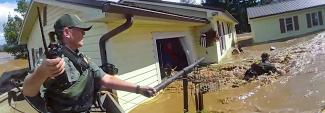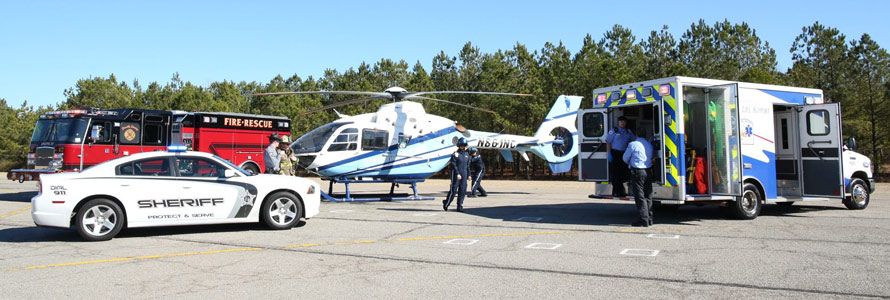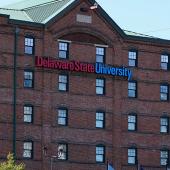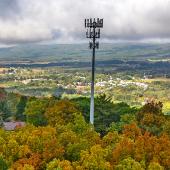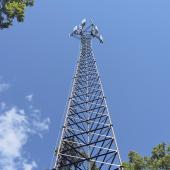This blog is a repost from Urgent Communications, originally published on June 2, 2025.
This blog post is part of the “Tech Talk” series focused on the First Responder Network Authority’s (FirstNet Authority) standards development activities to support public safety. This post recaps discussions linked to public safety and other related topics from the 3GPP plenary meetings that were conducted in March 2025. The FirstNet Authority represented public safety interests at the plenary meetings.
In March 2025, the First Responder Network Authority (FirstNet Authority) standards team participated in a 3GPP 6G Workshop, followed by the quarterly 3GPP Plenary meetings in Incheon, Korea.
The 3GPP 6G Workshop held March 10-11, 2025, brought together industry leaders, vendors, academics, and operators to discuss the standards-setting process for 6G. In response to the visions and priorities presented by 3GPP member companies, chairs of Radio Access Network (RAN), Service and System Aspects (SA) and Core Terminal (CT) groups presented a summary document of potential 6G technology areas for 6G study and tentative 3GPP 6G workplan/timelines.
The 6G Workshop summary document is expected to provide a baseline for RAN group 6G work for the next generation of radio technologies, whereas the SA/CT groups’ work will focus on the next generation of system architecture, core networks, and protocols.
While the industry remains very active in deploying 5G technologies, the standards organizations continue to work on high-level visions and use cases for 6G. This 6G work represents the next generation of wireless communications.
During the 3GPP Plenary meetings that took place March 12-14, 2025, 3GPP RAN, SA, and CT groups started work on the definition of the Release 20 (R20) scope. The groups also continued progressing Release 19 (R19) normative work and the study on 6G. The functional freeze date for R19 remains on track for the planned final completion date of December 2025.
The following report includes details on the 3GPP 6G Workshop and each of the 3GPP Plenary TSG meetings focused on progressing features important to public safety. The FirstNet Authority and government agencies of other nations continued to represent public-safety interests.
The 3GPP 6G Workshop
There were more than 1,650 registered members and more than 600 in-person attendees at the 6G workshop.
The two-day workshop started with a joint session to include SA, RAN, and CT plenaries. During this session, 3GPP member companies shared their visions for 6G, highlighting their motivation and goals from this new technology.
Common motivations cited during the session were support for new services and use cases, revenue growth and monetization, AI and automation, energy efficiency and sustainability, spectrum efficiency, ubiquitous coverage, total cost of ownership reduction, improved service reliability and customer experience, and network simplification.
The companies shared their common goal for 6G to provide sustainability, resilience, security, customer experience, efficiency, and interoperability. Other workshop breakout sessions focused on potential technical areas of 6G study for the RAN, core, and migration options.
The Radio Access Network TSG Plenary
More than 515 people attended the TSG RAN Plenary meeting. The RAN Plenary is responsible for defining the requirements, functions, and interfaces of the 3GPP radio access network.
The FirstNet Authority continues leading and championing the advancements of public-safety communications into the global standards of 3GPP R19, R20, and the future scope of 6G.
Multi-hop relaying is critical to extend off-network coverage for public-safety users. RAN plenary approved a revised work-item description (WID) of R19 layer 2 UE-to-Network (U2N) relaying feature—“NR (new radio) sidelink multi-hop relay”—with removal of a checkpoint for feasibility of 2 additional hops relays in R19 and specifying support for two additional hops relays on top of Rel-17 U2N relay. The normative work on R19 layer 2 U2N relaying continued to progress and is on track for completion by December 2025.
During this plenary, a considerable amount of time was spent on potential topics, features, and their scopes for R20. R20 will include normative work on features related to 5G-Advanced (5G-A) and study on 6G. R20 is the sixth release of 5G and the third release of 5G-A focusing solely on addressing critical commercial needs. This may include a FirstNet Authority-led proposal on NR sidelink UE-to-UE (U2U) multi-hop L2 relaying. This proposal has been included in the RAN chair’s summary as one of the potential proposals for discussion in the June 2025 RAN Plenary for R20 5G-A package.
While R20 is planned for an 18-month period, this timeframe will be dedicated to 5G-A and also include the study of several 6G topics. The group approved a study item on 6G scenarios and requirements—an action that marks the beginning of the 6G study in RAN groups. The RAN chair’s summary included several proposals as potential features for discussion in the June 2025 RAN Plenary. These proposals will be considered for inclusion in the R20 5G Advanced (5G-A) package for RAN working groups.
Some proposals for R20 with public-safety community support include sidelink enhancements such as Layer 2 U2U multi-hop relaying, Artificial Intelligence/Machine Learning (AI/ML) for NG-RAN—for example, AI for quality of experience optimization, and Integrated Sensing and Communication (ISAC) for Uncrewed Aerial Vehicles (UAV) use cases.
The satellite and public-safety communities also supported non-terrestrial-network (NTN) enhancements, such as low-rate codec for the support of Internet Protocol Multimedia Subsystem voice over geostationary earth orbit, Global Navigation Satellite System free/resilient operation of NTN, and terrestrial network (TN)-NTN mobility enhancements. Other proposals included the reduction in energy consumption in support of lowering operating expenses and network energy-savings techniques emphasizing sustainability.
The RAN1 working group is responsible for the specification of the physical layer of the radio interfaces. The working group reported steady progress on the R19 study and work items for high-priority features relevant to public safety.
These items included the work on AI/ML for NR Air Interface (65% completed), study on channel modeling for ISAC for NR (70% completed), and the solutions for Ambient Internet of Things (A-IoT) in NR (27% completed). The A-IoT devices, which are ultra-low in complexity and power for low-end IoT applications, address use cases and scenarios that cannot otherwise be fulfilled by existing Narrowband IoT, even with reduced peak Tx power.
The A-IoT feature allows wireless sensors—embedded in the personal protection equipment (PPE) of public-safety users—to derive energy from solar and/or wind power, eliminating the need for frequent change of batteries. The ISAC lets the network collect data on the range, velocity, position, size, and material makeup of objects in coverage areas to inform public safety’s situational-awareness needs.
The RAN2 working group is responsible for defining radio interface architecture and protocols. The working group has reported steady progress (60% completed) for R19 work on the FirstNet Authority-championed feature NR sidelink multi-hop U2N relay.
RAN2 also reported solid progress on other high priority R19 public-safety features, such as NTN for NR (75% completed), IoT NTN (70% completed), and inter Radio Access Technology mode for supporting mobility between LTE TN to NR-NTN (98% completed). NTN for NR enhancements expand coverage beyond terrestrial mobile networks (e.g., to rural and remote unserved and underserved areas). IoT NTN enhancements are important to provide connectivity beyond coverage of terrestrial networks for IoT sensors and devices, which can be integrated with—and relied upon—by the public-safety systems.
The RAN4 working group is responsible for work on radio-frequency aspects, including performing simulations and deriving the minimum requirements for transmission and reception parameters for UE devices.
RAN4 reported good progress (50% completed) for core part work on Introduction of Ku Bands (commonly used for satellite communication and currently being leveraged by 3GPP for satellite-based 5G services) for NR NTN. This work also defines the requirements for the support of different Mobile Very-Small-Aperture Terminal (MVSAT) types operating with non-geostationary orbit constellation in above 10 GHz bands allocated to satellite services. MVSAT can be mounted on moving platforms—for example, automotive, aircraft, train, and ship transport—for use by first responders to support public-safety use cases operating in Ku bands connecting to NGSO satellites. MVSAT technology is uniquely positioned to meet evolving, ubiquitous connectivity demands.
The RAN5 working group – responsible for the development of UE conformance test specifications – typically works one to two releases behind the other working groups. The working group started work on UE Conformance - Protocol enhancements for Mission Critical Services (MCS) including Mission Critical (MC) Push-to-Talk, MC Video, and MC Data for Rel-17 over LTE and 5G ,with progress to date 23% completed.
This will be the first release of conformance testing work for MCS over 5G in RAN5, and a new series of UE conformance testing specifications for MCS over both LTE and NR/5G have been approved by RAN Plenary.
Other significant public-safety-related UE conformance test specifications development includes R17 NR sidelink single-hop UE-to-Network relay (80% completed), UE Conformance Solutions for R17 NR NTN (89% completed), UE Conformance Solutions for R18 NR NTN (10% completed), and R18 UE Conformance for IoT NTN (over 56% completed).
The Service and System Aspects TSG Plenary
There were more than 390 in-person attendees at the TSG SA Plenary meeting. TSG SA is responsible for the overall architecture and service capabilities of 3GPP based systems.
3GPP SA Plenary continued discussing the 5G-A features to direct the work that may be included in R20; however, the final features set will be finalized during the June Plenary.
Based on the SA2’s December 2024 3GPP SA Plenary agreement on the first set of features, participants discussed and finalized the study items for integration of satellite components in the 5G architecture (Phase 4 of this work), AI/ML enhancements, integrated sensing and communications, and energy efficiency.
The SA1 working group is responsible for the services and system requirements and typically works one release ahead of the other 3GPP working groups. SA1 has focused on R20 for the last three quarters, splitting into two focus areas. The first focus area was on 5G-advanced enhancements, and the second on 6G use cases and requirements.
SA1 reported steady progress on the 5G-A R20 features, with several of the study items marked as completed. Many of the 5G-A features are continued as enhancements to existing features like satellite access, network sharing, and energy efficiency. Most of these features have completed the study phase of development and are expected to see normative work begin in the next quarter.
The study on 6G started, and some basic use-case scenarios have been accepted. The group reported 6G study as 25% complete. The FirstNet Authority pushed to include existing MCS into the 6G study. This will help ensure that early releases of 6G will include support for MCS.
The SA2 working group – responsible for the 5G System and Evolved Packet System Architectures – reported the completion of all the studies and technical specifications for R19, which includes several high-priority features for public safety. These enhancements will increase communications coverage and throughput in weak and off-network areas.
Public-safety high-priority features include ProSe enhancements, the support for multi-hop UE-to-Network relay and multi-hop UE-to-UE relay, enhancements to the vehicle-mounted relay that include backhaul support over NTN, Femtocell enhancements, Ambient-IoT, and artificial intelligence and machine learning. Additionally, a phase 3 enhancement to UAV was accepted that promises to improve the detection, avoidance, and communications capabilities of UAV systems.
The SA3 working group is responsible for 5G Security Aspects. The working group began work on a study to inventory all security protocols relevant for a future quantum-safe cryptography transition. This work will ensure 3GPP systems can leverage the latest quantum safe cryptographic algorithms when needed.
SA3 also started a security work item for R19 ProSe enhancements. This work will complete the normative work needed to address security issues introduced with the new multi-hop relaying capabilities.
The SA6 working group develops the architectures for most mission-critical (MC) features. The working group reported all SIs are 100% complete.
The most significant public-safety feature in R19 is the MCS support for single-hop relay services for both U2U and U2N. The work item previously reported a generic Isolated Operation for Public Safety (IOPS) mode for communication for 5G progressed to 100% completion in a single quarter, and both the study and normative work are complete as part of R19.
IOPS will allow for a limited MCPTT and MCData operations, even when backhaul from a cell site—or a group of cell sites--has been severed. SA6 has started discussions on R20 SIs, and—for public safety—new studies for discreet listening and monitoring, as well as for logging and recording. Also, a new work item championed by the FirstNet Authority for MCS over multi-hop U2U and U2N was approved.
The Core Network and Terminals (CT) TSG Plenary
There were more than 225 in-person attendees at the TSG CT Plenary meeting. This group covers the protocol details that follow and support the requirements and architectural work defined by the TSG SA groups.
The CT group reported a continued decrease in R18 change requests, because many of the submitted requests were determined to be not appropriate for R18 and moved to R19. The main work now is focused on R19 features.
There are many new work items started across four different subgroups, including eight items that are of interest to public safety. Two of these projects are existing projects, and the rest are the enhancements to mission-critical location (50% completed) and mission-critical services protocols (30% completed).
Further information on the 3GPP’s work and organization can be found at: www.3gpp.org.
Mark Lipford is the FirstNet Authority’s acting senior director of standards. Contributors to this article include FirstNet Authority Senior Standards Engineers Ihab Guirguis and Satish Jha, and the National Institute of Standards and Technology’s Jeff Cichonski.





